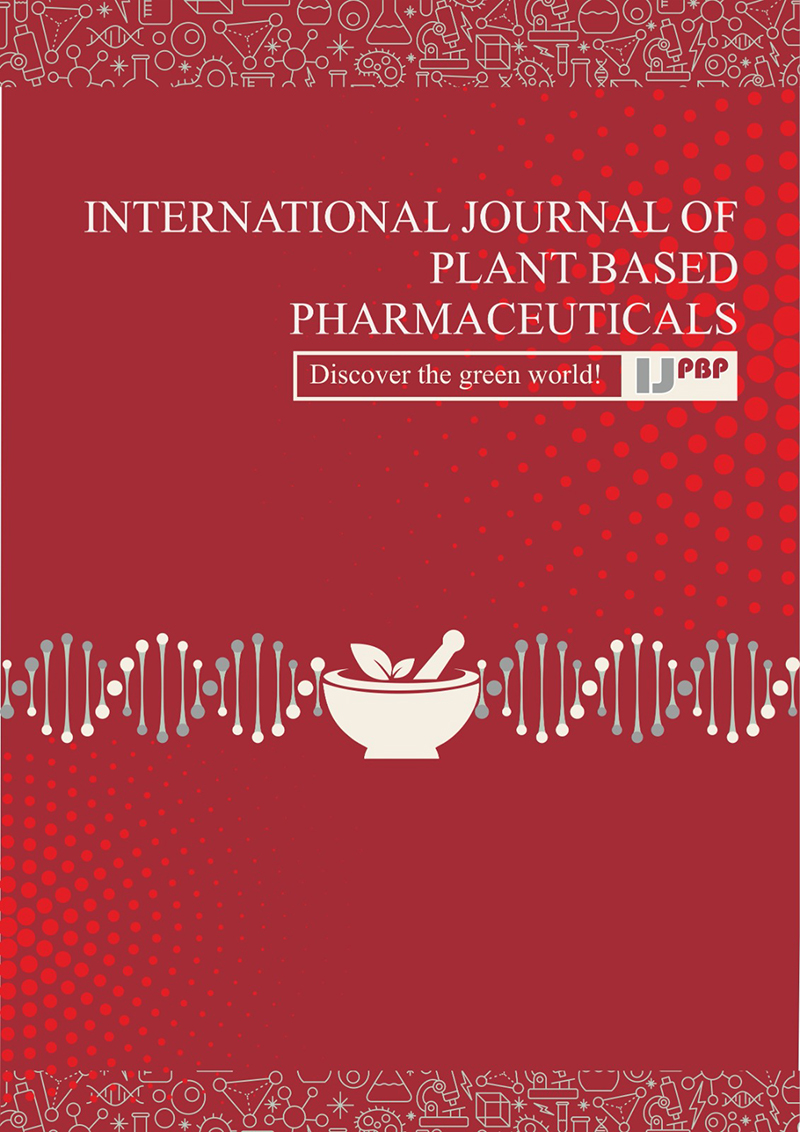Phenolic compounds of natural knotweed (Polygonum cognatum Meissn.) populations from Turkey
DOI:
https://doi.org/10.62313/ijpbp.2022.14Keywords:
Knotweed, Phenolic compounds, Polygonum cognatum, TurkeyAbstract
The phenolic compositions of two different Polygonum cognatum samples collected from the Cumra and Manisa regions of Turkey were investigated for the first time. Both tested samples were rich in different phenolic compounds, mostly rutin, isorhamnetin, and catechin. The rutin content of Cumra’s sample was relatively higher than that of Manisa’s sample. P. cognatum has potential regarding rutin content as a functional dietary food or may be used as an ingredient to enrich functional foods. Our study will contribute to the previous works performed by different researchers on P. cognatum, commonly consumed in Turkey, to reveal its beneficial properties.
References
Atanassova, M., Bagdassarian, V., 2009. Rutin content in plant products. Journal of the University of Chemical Technology and Metallurgy, 44(2), 201-203.
Baytop, T., 1999. Therapy with Medicinal Plants in Turkey Past and Present. Nobel Tip Kitab Evleri, Istanbul, p. 480.
Bondonno, C. P., Bondonno, N. P., Shinde, S., Shafaei, A., Boyce, M.C., Swinny, E., Hodgson, J.M., 2020. Phenolic composition of 91 Australian apple varieties: towards understanding their health attributes. Food & Function, 11(8), 7115-7125. DOI: https://doi.org/10.1039/D0FO01130D
Chu, X., Sun, A., Liu, R., 2005. Preparative isolation and purification of five compounds from the Chinese medicinal herb Polygonum cuspidatum Sieb. et Zucc by high-speed counter-current chromatography. Journal of Chromatography A, 1097(1-2), 33-39. DOI: https://doi.org/10.1016/j.chroma.2005.08.008
Davis, P.H., 1967. Flora of Turkey and the East Aegean Islands. Edinburg University Press.
Dinc, S., Kara, M., Karipcin, M.Z., Sari, N., Can, Z., Cicekci, H., Akkus, M., 2018. The rootstock effects on agronomic and biochemical quality properties of melon under water stress. FEB-Fresenius Environmental Bulletin, 27(7) 5008-5021.
Dereli, F.T.G., Ilhan, M., Kozan, E., Akkol, E.K., 2019. Effective eradication of pinworms (Syphacia obvelata and Aspiculuris tetraptera) with Polygonum cognatum Meissn. Experimental Parasitology, 196, 63-67. DOI: https://doi.org/10.1016/j.exppara.2018.09.006
Jansone, B., 2015. Assessment report on Polygonum aviculare L. herba. Committee on Herbal Medicinal Products (HMPC), 33 pp.
Jiang, P., Burczynski, F., Campbell, C., Pierce, G., Austria, J.A., Briggs, C.J., 2007. Rutin and flavonoid contents in three buckwheat species Fagopyrum esculentum, F. tataricum, and F. homotropicum and their protective effects against lipid peroxidation. Food Research International, 40(3), 356-364. DOI: https://doi.org/10.1016/j.foodres.2006.10.009
Kandakumar, S., Manju, D.V., 2017. Pharmacological applications of isorhamnetin: A short review. International Journal of Trend in Scientific Research and Development, 1, 672-678. DOI: https://doi.org/10.31142/ijtsrd2202
Kara, M., Dinc, S., Kahraman, S., Karipcin, M.Z., Alp, I., Cicekci, H., 2015. Ground Urfa isot peppers with high content of bioactive compounds and antioxidant activity. Zeitschrift für Arznel-und Gewürzpflanzen, 20(4), 158-164.
Kiokias, S., Proestos, C., Oreopoulou, V., 2020. Phenolic acids of plant origin—A review on their antioxidant activity in vitro (o/w emulsion systems) along with their in vivo health biochemical properties. Foods, 9(4), 534. DOI: https://doi.org/10.3390/foods9040534
Kreft, I., Fabjan, N., Yasumoto, K., 2006. Rutin content in buckwheat (Fagopyrum esculentum Moench) food materials and products. Food Chemistry, 98(3), 508-512. DOI: https://doi.org/10.1016/j.foodchem.2005.05.081
Kuo, C.H., Chen, B.Y., Liu, Y.C., Chang, C.M.J., Deng, T.S., Chen, J.H., Shieh, C.J., 2014. Optimized ultrasound-assisted extraction of phenolic compounds from Polygonum cuspidatum. Molecules, 19(1), 67-77. DOI: https://doi.org/10.3390/molecules19010067
Lorenzo, J.M., Munekata, P.E.S., 2016. Phenolic compounds of green tea: Health benefits and technological application in food. Asian Pacific Journal of Tropical Biomedicine, 6(8), 709-719. DOI: https://doi.org/10.1016/j.apjtb.2016.06.010
Macar, O., Kalefetoglu, T., 2018. Altitude Triggers Some Biochemical Adaptations of Polygonum cognatum Meissn. Plants. Cumhuriyet Science Journal, 39(3), 621-627. DOI: https://doi.org/10.17776/csj.375050
Önen, H., Altuntaş, E., Özgöz, E., Bayram, M., Özcan, S., 2014. Moisture effect on physical properties of knotweed (Polygonum cognatum Meissn.) seeds. Journal of Agricultural Faculty of Gaziosmanpaşa University, 31(2), 15-24. DOI: https://doi.org/10.13002/jafag670
Önen, H., Yılar, M., Kaya, C., 2009. Phenolic composition of madimak (Polygonum cognatum Meissn.) Plants, 3rd Plant Protection Congress, Van, Turkey, Abstract Book page 275.
Polat, R., 2019. Ethnobotanical study on medicinal plants in Bingöl (City center)(Turkey). Journal of Herbal Medicine, 16, 100211. DOI: https://doi.org/10.1016/j.hermed.2018.01.007
Sargin, S.A., Selvi, S., López, V., 2015. Ethnomedicinal plants of Sarigöl district (Manisa), Turkey. Journal of Ethnopharmacology, 171, 64-84. DOI: https://doi.org/10.1016/j.jep.2015.05.031
Ulusoy, H.İ., Acıdereli, H., Tutar, U., 2017. Optimization of extraction parameters for fat soluble vitamins and major element analysis in Polygonum cognatum Meissn plant (Madimak). Journal of the Turkish Chemical Society Section A: Chemistry, 4(1), 165-178. DOI: https://doi.org/10.18596/jotcsa.287323
Ulusoy, S., Erdoğan, S., Karaslan, M.G., Ates, B., Ulusoy, H.İ., Erdemoğlu, S., 2018. Optimization Of Extraction Parameters For Folic Acid And Antioxidant Compounds From An Edible Plant (Polygonum cognatum Meissn) Using Pressurized Liquid Extraction (PLE) System. Cumhuriyet Science Journal, 39(4), 1069-1080. DOI: https://doi.org/10.17776/csj.460289
Wang, D.G., Liu, W.Y., Chen, G.T., 2013. A simple method for the isolation and purification of resveratrol from Polygonum cuspidatum. Journal of Pharmaceutical Analysis, 3(4), 241-247. DOI: https://doi.org/10.1016/j.jpha.2012.12.001
Yıldırım, A., Mavi, A., Kara, A.A., 2003. Antioxidant and antimicrobial activities of Polygonum cognatum Meissn extracts. Journal of the Science of Food and Agriculture, 83(1), 64-69. DOI: https://doi.org/10.1002/jsfa.1288
Downloads
Published
How to Cite
Issue
Section
License
Copyright (c) 2022 Ahmet Gümüşçü, Saliha Dinç, Meryem Kara, Mehmet Akkuş, Gönül Gümüşçü

This work is licensed under a Creative Commons Attribution 4.0 International License.
The papers published in the International Journal of Plant Based Pharmaceuticals are licenced under Creative Commons Attribution 4.0 International Licence (CC BY).






